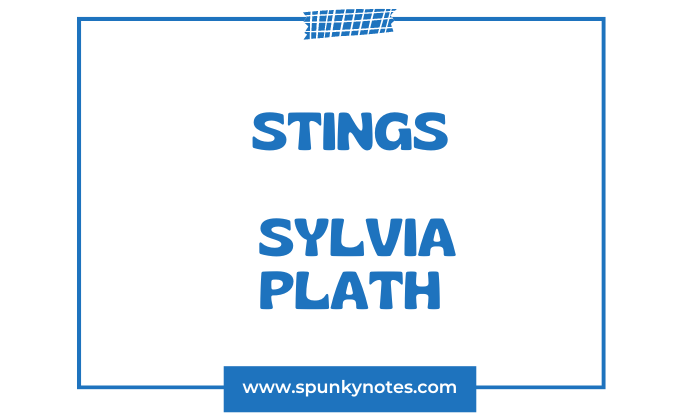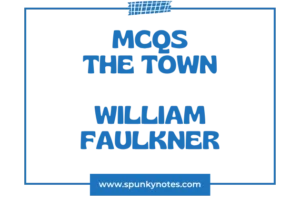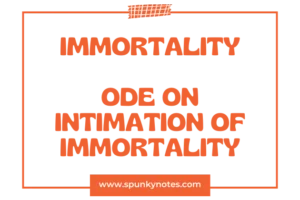

Estimated Reading Time: 19 min
Q. Critically analyse the poem Stings by Sylvia Plath.
Sylvia Plath’s “Stings” is a poem about power, identity, and self-discovery, using bees as a metaphor. The speaker works with bees and observes their behavior, especially focusing on the queen bee.
The bees and their hive symbolize struggle, pain, and survival, while the queen represents strength, leadership, and potential.
The speaker compares herself to the bees and reflects on her life. She rejects being seen as a weak or subservient figure and desires to find her true self like a queen bee taking control of her hive.
The stings and dangers she faces symbolize the pain she has endured but also show her strength and determination to move forward.
Ultimately, the poem is about overcoming struggles, finding inner power, and embracing the possibility of freedom and transformation, much like the queen bee rising above the hive.
Line by Line explanation of the poem Stings by Sylvia Plath
Stanza 1
Bare-handed, I hand the combs.
The man in white smiles, bare-handed,
Our cheesecloth gauntlets neat and sweet,
The throats of our wrists brave lilies.
He and I
Bare-handed, I hand the combs.
The speaker describes handling the honeycombs with her bare hands, emphasizing vulnerability and direct engagement with the bees.
This act shows her willingness to face the danger of stings, reflecting courage and a connection to the task.
The man in white smiles, bare-handed,
The “man in white” is likely the beekeeper or a figure assisting her. His bare hands, like hers, highlight shared exposure to risk.
His smile could suggest confidence, calmness, or detachment in contrast to the speaker’s deeper emotional connection to the moment.
Our cheesecloth gauntlets neat and sweet,
Cheesecloth is a thin, loose cotton cloth for light gloves (gauntlets). This phrase softens the image of protection, suggesting a sense of delicacy and precision in their actions, but it also adds a slightly ironic tone, as the danger of stings is still present.
The throats of our wrists brave lilies.
This metaphor compares their exposed wrists to “brave lilies.” Lilies are delicate flowers, and calling them “brave” suggests a mix of fragility and courage.
It highlights the vulnerability of their unprotected skin, which is close to the threat of bee stings, yet they willingly face the danger.
He and I
The line focuses on the relationship between the speaker and the “man in white.” It sets up a partnership in this shared task, though their perspectives or experiences may differ.
Stanza 2
Have a thousand clean cells between us,
Eight combs of yellow cups,
And the hive itself a teacup,
White with pink flowers on it,
With excessive love, I enamelled it
In Sylvia Plath’s “Stings,” the poem describes the speaker’s deep commitment to beekeeping, emphasizing her care and attention to the task.
Have a thousand clean cells between us,
The speaker notes the physical separation created by the honeycomb, which consists of thousands of small, clean, hexagonal cells.
These cells symbolize both the hive’s structured, orderly nature and the emotional or symbolic distance between the speaker and the “man in white.”
Eight combs of yellow cups,
This line describes the honeycomb as “yellow cups,” referring to the vibrant, golden appearance of the cells filled with honey or wax. The “eight combs” emphasize abundance and the hive’s industrious nature.
And the hive itself a teacup,
The hive is compared to a teacup, suggesting something small, delicate, and precious. This comparison conveys the speaker’s affection for the hive and her view of it as a beautiful, almost domestic object despite its dangers.
White with pink flowers on it,
The description of the teacup-like hive with “pink flowers” reinforces its delicate, ornamental quality. This imagery brings a sense of fragility and charm to the hive, contrasting with the intense labour and survival.
With excessive love, I enamelled it.
The speaker admits to decorating or “enameling” the hive with “excessive love.” This suggests her deep emotional connection to it, perhaps even an overattachment.
The act of enamelling implies making the hive more beautiful and personal, reflecting her desire to protect and idealize it.
Enameled
Enameling means coating something with a smooth, durable, glossy finish. This process involves heating powdered glass to a substrate (such as metal or ceramics).
In the poem, “enamel” is used metaphorically to describe the speaker’s act of lovingly caring for and beautifying the hive, suggesting a transformation of the hive into something precious and protected.
Stanza 3
Thinking ‘Sweetness, sweetness.’
Brood cells gray as the fossils of shells
Terrify me, they seem so old.
What am I buying, wormy mahogany?
Is there any queen at all in it?
In this stanza of Sylvia Plath’s poem “Stings,” the speaker reflects on her thoughts and feelings about beekeeping. They think about the sweetness produced by the bees, likely referring to honey, which contrasts with their fear and uncertainty.
Thinking ‘Sweetness, sweetness.’
The speaker initially associates the hive and its honey with sweetness and comfort. This thought reflects an expectation of something pure, pleasant, and life-affirming.
Brood cells gray as the fossils of shells
The brood cells hold young bees as they grow. They look gray and old, like fossils. This makes them seem decayed, ancient, and lifeless.
This disturbs the speaker, as the cells seem devoid of vitality and far removed from the initial sweetness she imagined.
Terrify me, they seem so old.
The speaker expresses fear and discomfort, finding the brood cells eerie and ancient. Their appearance evokes a sense of mortality, decay, and the passage of time, challenging the initial sweetness she associated with the hive.
What am I buying, wormy mahogany?
The speaker questions the value of her work, comparing it to “wormy mahogany.” While mahogany is a valuable, beautiful wood, “wormy” implies it is infested, damaged, or flawed.
This suggests that there may be hidden decay or disappointment beneath the hive’s outward sweetness and structure.
Is there any queen at all in it?
The speaker wonders if the hive even has a queen, which is essential for its survival and vitality. Without the queen, the hive loses its purpose and unity.
This question reflects doubt and a search for meaning or leadership, both within the hive and symbolically in her own life.
Stanza 4
If there is, she is old,
Her wings torn shawls, her long body
Rubbed of its plush —-
Poor and bare and unqueenly and even shameful.
I stand in a column
If there is, she is old,
The speaker imagines the queen bee but not as a figure of vitality and power. Instead, she envisions her as aged, weak, and diminished, suggesting a loss of strength or purpose.
Her wings torn shawls, her long body
The queen bee’s wings are compared to “torn shawls,” evoking an image of fragility and wear. Once plush and regal, her body is now described as worn and threadbare, emphasizing her decline.
Rubbed of its plush —-
This phrase further highlights the queen’s diminished state. The “plush,” which might have once symbolized her authority, beauty, and power, has been eroded, leaving her exposed and vulnerable.
“Plush” usually refers to a rich, soft fabric. Here, it metaphorically describes the queen bee’s once smooth and perhaps velvety body, now worn down to a state lacking its former softness or richness.
Poor and bare and unqueenly and even shameful.
The queen is stripped of her majesty and dignity, appearing “unqueenly” and even “shameful.” These words reflect a sense of pity and perhaps discomfort with this figure, who no longer embodies the strength and vitality expected of her role.
This could also symbolize the speaker’s feelings about aging, loss of power, or the vulnerability of leadership.
I stand in a column
The speaker places herself within a “column,” which could symbolize order, structure, or perhaps conformity. It suggests a sense of being part of a larger system, like the bees in their hive, but also implies stillness and possibly isolation.
Stanza 5
Of winged, unmiraculous women,
Honey-drudgers.
I am no drudge
Though for years I have eaten dust
And dried plates with my dense hair.
Of winged, unmiraculous women
The bees are described as “winged” because they can fly, but “unmiraculous” highlights that their lives lack wonder or freedom. Their existence is bound to repetitive labor, making them ordinary rather than extraordinary.
Honey-drudgers
This refers to the worker bees, whose lives revolve around endlessly producing honey. The term “drudgers” emphasizes the monotonous, tiresome nature of their work, as they labor without joy or recognition.
It suggests that these women work hard like bees collecting honey, but their labour is monotonous.
I am no drudge
The speaker asserts that she is not a “drudge,” meaning she refuses to live a life of hard, thankless, and unfulfilling labor. This is a declaration of independence and self-worth.
A drudge is someone who does tedious, complex, and continuous work. The speaker asserts she is not a drudge, indicating she does not view herself as someone resigned to monotonous labour.
Though for years I have eaten dust
“Eating dust” is a metaphor for enduring hardship or living through degrading and difficult times. It reflects the speaker’s past struggles and survival in harsh circumstances.
And dried plates with my dense hair
This surreal image suggests a life of domestic servitude or thankless work. Drying plates (dishes) with her “dense hair” symbolizes being used or reduced to a tool for mundane tasks, further demeaning her sense of self.
Stanza 6
And seen my strangeness evaporate,
Blue dew from dangerous skin.
Will they hate me,
These women who only scurry,
Whose news is the open cherry, the open clover?
And seen my strangeness evaporate,
The speaker reflects on losing her uniqueness or individuality, as if it had faded away, like “strangeness evaporating.” This suggests a sense of becoming ordinary or losing what made her distinct, perhaps due to conforming to socially repetitive labor.
Blue dew from dangerous skin.
The “blue dew” could symbolize something rare, beautiful, or unique that has disappeared. “Dangerous skin” might refer to her vulnerability or the risks she has taken, suggesting that her boldness or individuality has faded away over time.
Will they hate me,
The speaker wonders if the other women, represented by the worker bees, will resent or reject her. This question reflects her fear of judgment or alienation because she refuses to conform to their way of life.
These women who only scurry,
The worker bees, described as “women who only scurry,” are depicted as living hurried, mechanical lives focused solely on labor.
The word “scurry” emphasizes their restless, repetitive movement, showing how they are trapped in a cycle of endless work.
Whose news is the open cherry, the open clover?
The bees’ “news” is the discovery of flowers like cherries and clovers, which provide nectar for honey. This line suggests that their entire existence revolves around gathering resources, with little thought or purpose beyond their immediate tasks.
Symbolically, it reflects a life limited to mundane or practical concerns, lacking broader imagination or ambition.
Scurry
This means to move quickly with short, hurried movements. It is used here to describe other women busy with daily tasks, emphasizing immediate, simple activities.
Stanza 7
It is almost over.
I am in control.
Here is my honey-machine,
It will work without thinking,
Opening, in spring, like an industrious
It is almost over.
The speaker reflects on nearing the end of a problematic or transformative process. This could signify the conclusion of her struggle for self-discovery, control, or liberation.
I am in control.
Here, the speaker asserts her newfound power and agency. She no longer feels dominated by external forces or trapped in repetitive, thankless work. This statement reflects a moment of triumph and confidence.
Here is my honey-machine,
The “honey machine” refers to the beehive or the system of labor that produces honey. By calling it “my honey machine,” the speaker claims ownership and control over this previously oppressive system and transforms it into something that serves her.
It will work without thinking,
This line emphasizes the mechanical, automatic nature of the hive’s operation. The bees work instinctively, without needing thought and emotion, continuing their industrious tasks in a predictable cycle.
Opening, in spring, like an industrious
The mention of “spring” represents new beginnings, growth, and productivity. The hive’s industrious activity reflects the bees’ constant energy and hard work. This context shows that the system will thrive under the speaker’s control and vision.
Stanza 8
To scour the creaming crests
As the moon, for its ivory powders, scours the sea.
A third person is watching.
He has nothing to do with the bee-seller or with me.
Now he is gone
To scour the creaming crests
This line evokes the image of waves with frothy white tops, described as “creaming crests.” The verb “scour” suggests an intense, purposeful searching or cleansing, creating a vivid sense of movement and energy, as if nature is working tirelessly.
As the moon, for its ivory powders, scours the sea.
The moon is personified as searching the sea for “ivory powders,” a poetic image of moonlight reflecting off the ocean’s surface.
This line ties the natural cycles of the moon and sea to the hive’s tireless labor, reinforcing themes of ceaseless effort and the connection between nature’s rhythms and human or bee activity.
A third person is watching.
The speaker introduces a mysterious “third person,” an observer who seems detached from the speaker and the “bee-seller.” This figure might represent an outsider, a symbolic presence, or even the speaker’s sense of being watched.
He has nothing to do with the bee-seller or with me.
The speaker clarifies that the third person is uninvolved with the central events or characters, emphasizing their role as a distant observer.
This detachment could symbolize societal indifference, a judgmental gaze, or even a divine or external force.
Now he is gone.
The third person disappears, leaving the scene. His sudden absence suggests that his presence was fleeting and perhaps insignificant, or it could reflect the speaker’s movement beyond the feeling of being observed or judged.
Stanza 9
In eight great bounds, a great scapegoat.
Here is his slipper, here is another,
And here the square of white linen
He wore instead of a hat.
He was sweet,
In eight great bounds, a great scapegoat.
In this part of the poem, the speaker describes someone who moves quickly, using “eight great bounds” to show how fast and powerfully the person is moving.
The term “great scapegoat” suggests this person might be blamed for things that are not his fault, as a scapegoat is unfairly made to take the blame for others.
Here is his slipper, here is another,
The mention of slippers left behind suggests haste or abandonment as if the figure fled so quickly that his belongings were scattered. This detail adds a sense of urgency and vulnerability to his departure.
And here the square of white linen
The “square of white linen” likely refers to an item of clothing left behind, such as a handkerchief or head covering.
White linen can symbolize purity or innocence, perhaps suggesting that the scapegoat carries an unjust burden of blame or guilt.
He wore instead of a hat.
This detail describes the linen as a replacement for a hat, further emphasizing the simplicity or improvised nature of the scapegoat’s appearance.
It might suggest humility, poverty, or a lack of preparation, reinforcing the image of someone not equipped for the role imposed upon him.
He was sweet,
The scapegoat is described as “sweet,” suggesting a gentle, kind, or innocent nature. This contrasts with the burden he bore or the situation that forced him to flee, emphasizing the unfairness of his treatment.
Stanza 10
The sweat of his efforts a rain
Tugging the world to fruit.
The bees found him out,
Molding onto his lips like lies,
Complicating his features.
In this part of the text, the speaker describes someone who works very hard, so much so that his sweat is compared to rain, which helps plants grow fruit.
The sweat of his efforts a rain
The speaker describes the scapegoat’s hard work, with his sweat likened to rain. This emphasizes the physical toll of his efforts, suggesting he poured himself into his labor or sacrifice.
Tugging the world to fruit.
The scapegoat’s efforts are portrayed as crucial to bringing life and sustenance, symbolized by “fruit.” This line suggests his labor or sacrifice benefits others, even if it comes at his own expense.
When used metaphorically, as in “tugging the world to fruit,” it suggests exerting influence or making a solid effort to produce results, like causing plants to bear fruit.
The bees found him out,
The bees discover the scapegoat, perhaps drawn to the sweat of his hard work or the sweetness of his essence. This discovery might symbolize exposure, scrutiny, or even exploitation of his vulnerabilities.
Molding onto his lips like lies,
It suggests they are clinging to or covering his mouth in a way that might alter or hide his speech or expressions. Comparing this to “lies” suggests deceit or false narratives surrounding the scapegoat.
It implies that the scapegoat might have been unfairly accused or misrepresented, adding complexity to his role.
Complicating his features.
The bees on his face distort his appearance, symbolizing blame, guilt, or falsehoods obscuring his identity. His “features” being “complicated” suggests a loss of clarity or individuality, as if his true self is hidden beneath the burden of others’ perceptions.
“Complicating his features” means that bees on his face make it hard to see his true expression or feelings, adding complexity to his appearance or the situation.
Stanza 11
They thought death was worth it, but I
Have a self to recover, a queen.
Is she dead? Is she sleeping?
Where has she been,
With her lion-red body, her wings of glass?
They thought death was worth it, but I
The speaker says that others, likely the worker bees, believed their work and sacrifices were meaningful, even if they led to death.
The worker bees die after stinging, and their lives are entirely dedicated to the hive. The speaker disagrees with this mindset. She values something more than blind sacrifice.
Have a self to recover, a queen.
The speaker feels she has lost her true self and needs to find it again. She compares her journey to finding a queen bee. The queen represents strength, power, and independence, qualities the speaker wishes to reclaim in her own life.
Is she dead? Is she sleeping?
The speaker questions the queen’s condition. She wonders if the queen bee is dead, showing a complete loss, or just sleeping, suggesting that her strength and individuality might still exist but are temporarily inactive. These questions show the speaker’s uncertainty about her ability to recover her true self.
Where has she been,
The speaker wonders where the queen has been. This reflects her feelings of absence or distance from her identity and purpose.
She feels as though her power and individuality have been missing for a long time, and she doesn’t know where or why.
With her lion-red body, her wings of glass?
The speaker describes the queen bee’s physical characteristics. The “lion-red body” suggests boldness, strength, and courage, similar to the traits of a lion.
The “wings of glass” symbolize beauty but also fragility. These details show the speaker’s admiration for the queen, who is both powerful and delicate, and they reflect the qualities the speaker wants to rediscover in herself.
Stanza 12
Now she is flying
More terrible than she ever was, red
Scar in the sky, red comet
Over the engine that killed her —-
The mausoleum, the wax house.
Now she is flying
The speaker describes the queen bee as alive and in motion, reclaiming her power and autonomy. This suggests a moment of transformation or liberation, where the queen, symbolically the speaker herself, has regained strength and control.
More terrible than she ever was, red
The queen is described as more powerful and fearsome than before. The word “terrible” does not imply negativity but awe-inspiring strength and force.
The color red emphasizes her vitality, boldness, and the intensity of her presence, linking to themes of passion and power.
Scar in the sky, red comet
The queen is compared to a “scar in the sky,” symbolizing a permanent, striking mark of her resilience and survival.
The “red comet” represents the queen’s power, speed, and intensity. A comet is bright and unforgettable, moving with force and purpose across the sky. The red colour adds emotion, symbolizing passion, strength, or even the pain she has endured.
This image shows that the queen is not just surviving but moving forward with unstoppable energy, leaving a bold and lasting impact.
Over the engine that killed her —-
The queen flies over what the speaker calls the “engine that killed her.” This might mean the hive or system that took away her energy.
It could also represent society’s rules, hard work, or control. Her flying shows that she has defeated what once hurt her and is now free and strong again.
The mausoleum, the wax house.
The hive is described as a “mausoleum” and a “wax house,” emphasizing its suffocating and lifeless nature. A mausoleum is a large tomb. It symbolizes death, stillness, and entrapment.
This description of the hive shows that it has become lifeless and oppressive. It suggests a place where vitality and individuality are suppressed.
Wax House
The phrase “wax house” refers to the physical structure of the hive, which is made of wax. It also implies confinement and monotony. In this environment, the bees work tirelessly without rest.
The queen’s flight above these symbols represents her liberation. She has escaped the hive’s constraints and expectations, marking her freedom from a life of confinement and endless toil. The imagery shows her transformation and newfound independence.


